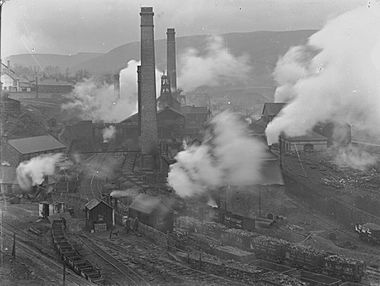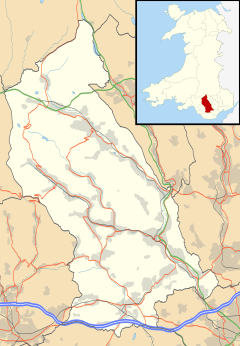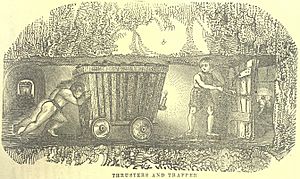Cymmer Colliery explosion facts for kids
Quick facts for kids 
Cymmer Colliery c. 1905
|
|
| Date | 15 July 1856 |
|---|---|
| Location | Cymmer Colliery near Porth, Wales |
| Type | Underground gas explosion |
| Cause | Poor mine ventilation and the use of open flames underground |
| Deaths | 114 men and boys |
| Inquiries | Coroner's inquest: July 1856 |
| Coroner | George Overton |
The Cymmer Colliery explosion happened early on July 15, 1856. It took place at the Old Pit mine of the Cymmer Colliery near Porth in Wales. This mine was run by George Insole & Son. A gas explosion deep underground led to a huge loss of life. One hundred and fourteen men and boys were killed. Many families lost their main providers, including 35 widows and 92 children.
The explosion happened because the mine's air circulation was poor. Also, miners were using open flames underground. Other things that contributed to the disaster included the mine growing too fast to meet coal demand. There were also unsafe practices allowed by the management, even after warnings. The relationship between miners and management was also getting worse.
After the explosion, the mine owner, James Harvey Insole, and his officials faced serious accusations. People said they had "neglected the commonest precautions for the safety of the men." At the official investigation into the deaths, Insole tried to blame his mine manager, Jabez Thomas. The jury then accused Thomas and four other mine officials. However, the legal proceedings that followed found the mine officials not responsible for the disaster. This angered local mining communities.
The Cymmer Colliery disaster led to important safety changes in mines. These included new laws for better mine ventilation and the use of safety lamps. Rules about the employment of children and the qualifications of mine officials also improved. The tragedy showed that a good system was needed to help miners and their families after such disasters. This would reduce their reliance on public charity.
Contents
What Led to the Disaster?
The Cymmer Colliery Mine
George Insole and his son James Harvey Insole bought the Cymmer Colliery in 1844. In 1847, they dug the No. 1 Pit. After 1853, this became known as the Cymmer Old Pit. James Insole took over the business when his father died in 1851.
Between 1852 and 1855, a government inspector named Herbert Francis Mackworth visited the mine twice. He sent letters to Insole suggesting safety improvements. He especially focused on the mine's underground air system and the use of safety lamps underground.
Worker Safety Concerns
Miners depended on daily reports from the mine's safety workers (firemen) about gas dangers. In 1854, the mine manager, Jabez Thomas, suddenly fired two experienced firemen. He hired two new ones from outside the mine. The workers complained to Insole that they did not trust these new safety workers.
The miners refused to work under the new firemen. But Insole insisted on his right to hire and fire anyone he pleased. This led to a long strike by the miners, lasting twenty-two weeks. Losing money and facing legal threats, the miners eventually had to go back to work with the new firemen.
Increased Demand for Coal
By the mid-1800s, coal from the Rhondda area was in high demand. It was especially popular for making coke, a type of fuel. The Crimean War also created a greater need for coal. Because of this, in 1855, Insole sped up his mining work at the Old Pit. He doubled the number of miners and made the mine area over a third larger.
A Welsh historian, E. D. Lewis, wrote that the success of the Cymmer Old Pit mine, when it grew "with such inordinate speed and recklessness" by James Harvey Insole, directly caused the terrible mining disaster of 1856.
The Explosion Occurs
On Tuesday, July 15, 1856, 160 men and boys went down the Old Pit mine shaft. They were starting their 6:00 a.m. shift. As they walked to their workplaces underground, a gas explosion happened near the mine entrance. This trapped the miners who were already deeper inside the mine.
It took three hours for rescuers to reach the site. They found that many miners had gathered together as they ran out of air. By that evening, 112 bodies had been brought out. Another body was found the next day. A severely burned miner died the day after that. In his report, Mines Inspector Mackworth called the disaster "the most lamentable and destructive explosion" ever in any mine in the country or abroad.
Lasting Impact
Safety Changes at Cymmer Colliery
Mines Inspector Thomas Evans called the disaster "a huge loss of human life." The Cymmer Colliery disaster of 1856 changed coal mining practices, both locally and across the country. After another gas explosion at the colliery in December 1856, the Cymmer Old Pit and New Pit mines were connected. This created a safer system with two shafts and better air flow.
Even though mechanical mine ventilators had been used in the Lower Rhondda since 1851, they were installed at the Cymmer Colliery in the mid-1870s. Also by the mid-1870s, the mine management realized it was safer and cheaper to give miners safety lamps. The Insole company continued to work the Cymmer Old Pit until the mine closed in 1939.
National Mine Safety Laws
The disaster also influenced national laws. Many children were killed in the explosion. Because of this, the Mines Regulation Act 1860 made it illegal to employ boys under twelve years old. The only exception was if they could read and write and went to school for at least three hours a day, two days a week.
By 1865, having two shafts in mines became a requirement. Mackworth's safety suggestions from 1854 were also made into law in the Mines Act 1872. These suggestions included having a qualified mining engineer and enough skilled officers to manage the mine's machinery, air flow, and safety for workers. After the Cymmer Colliery explosion, steps were taken to create better ways to help families after fatal disasters. This would reduce their need for public charity. The first successful plan for this began in 1881.
See also
- List of disasters in Great Britain and Ireland by death toll



